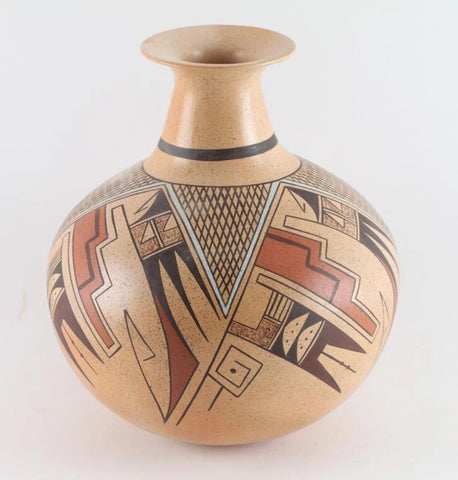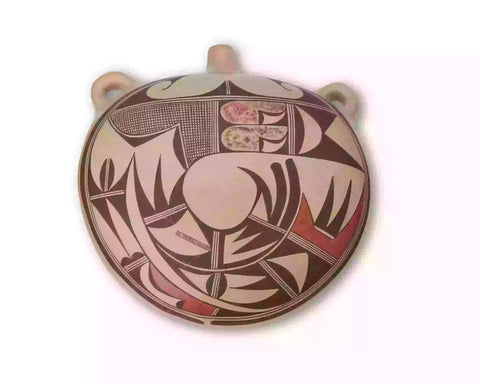
Hopi Pueblo Polychrome Pottery Canteen, mid/late 20th century by Pauline Setalla #1779 SOLD
$ 1,849.56
After a wonderful Thankgiving at home with just Linda and I, it is time to get back to work. It looks like Christmas is coming early this year. At the moment, I am waiting for receipt of another fantastic Hopi Pueblo Pottery Canteen for my collection. It is a mid/late 20th century piece by Pauline Setalla #1779. Details follow below.
Hopi Pueblo Polychrome Pottery Canteen, mid/late 20th century by Pauline Setalla #1779. More details available at culturalpatina.com, and culturalpatina.etsy.com.
Description: #1779, Hopi Pueblo Polychrome Pottery Canteen, mid/late 20th century by Pauline Setalla. The three-color canteen with corn cob and geometric motifs, cork stopper, and leather strap.
Pauline Setalla married into the Frog Woman/Feather Woman families. It was reported by her son that she is in ill health and has retired from making pottery. She had 10 children, some of whom are potters carrying on her legacy. She was raised in the village of Mishongovi on the Hopi Reservation. She learned pottery production techniques from her mother-in-law, Agnes Navasie, and her sister-in-law, Eunice Navasie. (Source: Adobe Gallery)
All of Setalla's pottery was formed in the traditional coil technique from native clay and slipped with vegetal paints and painted in the traditional manner. Firing was with sheep dung, a popular way at Hopi. (Source: Adobe Gallery)
Dimensions: 11" H x 9.5" W x 6.5" D
Provenance: Private Collection, Southern California
Condition: Overall good condition with shelf wear, scattered minor scuffs, and inherent firing flaws commensurate with age. With previous retailer's sticker to underside.
Hopi Pueblo Polychrome Pottery Canteen, mid/late 20th century by Pauline Setalla #1779. More details available at culturalpatina.com, and culturalpatina.etsy.com.
Description: #1779, Hopi Pueblo Polychrome Pottery Canteen, mid/late 20th century by Pauline Setalla. The three-color canteen with corn cob and geometric motifs, cork stopper, and leather strap.
Pauline Setalla married into the Frog Woman/Feather Woman families. It was reported by her son that she is in ill health and has retired from making pottery. She had 10 children, some of whom are potters carrying on her legacy. She was raised in the village of Mishongovi on the Hopi Reservation. She learned pottery production techniques from her mother-in-law, Agnes Navasie, and her sister-in-law, Eunice Navasie. (Source: Adobe Gallery)
All of Setalla's pottery was formed in the traditional coil technique from native clay and slipped with vegetal paints and painted in the traditional manner. Firing was with sheep dung, a popular way at Hopi. (Source: Adobe Gallery)
Dimensions: 11" H x 9.5" W x 6.5" D
Provenance: Private Collection, Southern California
Condition: Overall good condition with shelf wear, scattered minor scuffs, and inherent firing flaws commensurate with age. With previous retailer's sticker to underside.
Related Products
Sold out







